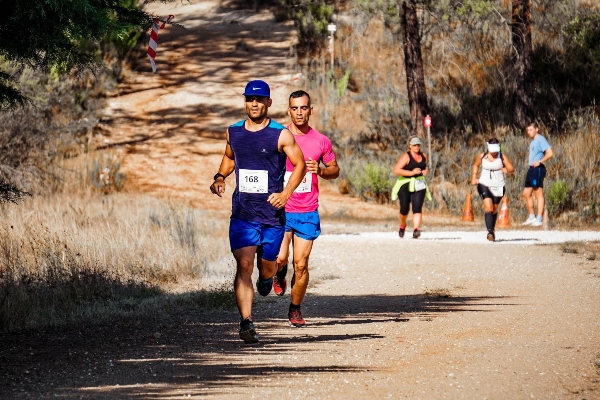Texas marathons deal runners a pretty good hand
By Paul Baltutis
I’m not a huge fan of poker, but there is a strategy you can use to help you select a big city half or full marathon this upcoming season in the Lone Star State. I call it “Texas hold ’em.” Because of the oppressively hot weather pattern in South Texas during the summer, it’s difficult to get in quality or quantity training. Most runners yearn for cool weather training and cool weather racing. Having said that, let’s look at the placement of the five largest city races in Texas: San Antonio is in November, Dallas is in December, Houston is in January and Austin and Ft. Worth are in February. I believe all five cities sat down and played a game of poker to decide which month they should hold their marathons. The winners and losers of the game are as follows:
Dallas came in first and claimed the month of December. Weather in Dallas during that time would be in the 35 – 50 degree range. Dallas is the first continuous marathon in Texas, having started in 1971. The race is known as the White Rock Marathon because of the 10-mile loop around one of the more popular jogging trails in the Dallas metropolitan area near White Rock Lake. The race is very popular and offers half marathon and a 5-person relay. The marathon averages just over 3,200 finishers, which puts it in the top 10 in the United States. One minor disadvantage is that the December date gives a runner only about six weeks of cool weather before race day. Go to runtherock.com for more information. I rate it as “three of a kind.”
Next was Houston. They astutely picked January. With the temperatures often averaging in January between 45 – 60 degrees, they picked their race for optimum weather conditions. The race started in 1972 and is now in its 35th year. Houston offers full, half and 5K events. Their marathon has a great reputation for community support and has experienced tremendous growth in the past several years. The course is flat and fast, and here is my favorite part: it has belly dancers at the 20-mile mark. The marathon has averaged 5,500 finishers the past three years, giving it the title “largest marathon finishers in Texas.” With a January date, you could expect 8 – 10 weeks of cool weather in which to train. Go to hphoustonmarathon.com. I rate Houston as “a full house.”
San Antonio was next, but organizers there couldn’t make up their minds about which month to hold their race. It started in May 1975, bounced around to October and settled in November. The San Antonio Marathon poses the greatest challenge for Texas runners because it is so early in the season and the temperatures haven’t cooled sufficiently to get in much quality training. The race offers a half marathon and a 5K. The marathon had an average of 900 finishers the past three years. There are some positives to report, however. This year’s marathon is offering a brand new course that starts at the Alamo and finishes inside the Alamodome. Go to the race Web site samarathon.org for more information. I rate it as a “pair of jacks.”
Fort Worth cashed in their chips next, starting their marathon in 1979 and picking February. Fort Worth offers the most events for their weekend. They offer a full, half, three-person relay, a 10K and a 5K. While the event offers the most events, Cowtown has the fewest marathon finishers, averaging about 650 the past three years. The month of February is favorable, weather-wise, and does give runners 14 to 16 weeks of good training conditions. Weather in February often brings race day temperatures in the mid 40s to the mid 50s. Their Website is cowtownmarathon.org. I rate it as a “flush.”
Austin was the last to select their dates, but they had the advantage of seeing what works, and what doesn’t. Austin also wisely picked the month of February. With nearly ideal temperatures, a fast downhill course and community support, Austin is the second largest marathon event in Texas, second only to Houston. For being the smallest sized city of the five, Austin’s numbers are impressive. Austin has averaged over 5,000 marathon finishers the past three years. They have a popular half marathon included on race day as well. Austin has had good corporate sponsorship in the past, but Motorola/Freescale has dropped their sponsorship for 2007. I believe Austin will continue to be a quality event and attract many regional runners. If you are shooting for a fast time and like the idea of several months of cool weather training, this is the race to shoot for this year Their Website is www.freescaleaustinmarathon.com. I rate it as a “straight flush.”
In all these races, there are some jokers in the deck, meaning weather can so be variable on race day. For example Austin had temperatures in the 70s in 2005 and in the low 30s in 2006. Bottom line: if you decide to train through the summer, by all means, play ’em if you’ve got ’em. (San Antonio/Dallas). But, if you want to improve your odds and do some sustained long distance training in cooler weather, play Texas hold ’em (Houston, Austin, Fort Worth). Hold ’em may very well turn up aces for you.
Paul Baltutis is the manager of Soler’s Sports in Alamo Heights. He is a certified marathon coach with Team in Training. He can be contacted at sage_run03@yahoo.com.






